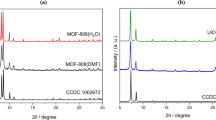Abstract
Hydrophobic (water CA, 155° ± 5°) monolithic silica (HMS) material with abundant pore was prepared via sol–gel method by using tetraethoxysilane as silicon source and trimethylchlorosilane as surface modification agent. High specific area and appropriate pores structure of the HMS material supply enough space for storing the absorbed molecules. The maximum adsorptive ability toward organic contaminants can reach 14 times the monolith’s weight. It is worth mentioning that saturated adsorption can be reached in a short time due to the interconnected macropores, which ensure that adsorbate diffuse in the bulk easily. In addition, it was verified that after an easy evaporation condensing treatment, the regenerated HMS material could retain its initial adsorption capacity. High adsorption capacities and good regeneration capability for organic-contaminants removal give the HMS material potential applications in wastewater treatment, chemical accident remediation, and environmental protection.






Similar content being viewed by others
References
Ayoko GA, Singh K, Balerea S, Kokot S (2007) J Hydrol 336:115
Jones AP (1999) Atmos Environ 33:4535
Wang D, McLaughlin E, Pfeffer R, Lin YS (2011) Chem Eng J 168:1201
Konishi M, Kishimoto M, Tamesui N, Omasa T, Shioya S, Ohtake H (2005) Biochem Eng J 24:49
Hoff RZ (1993) Mar Pollut Bull 26:476
Atlas RM (2007) J Chem Technol Biotechnol 52:149
Adebajo MO, Frost RL, Kloprogge JT, Carmody O, Kokot S (2003) J Porous Mater 10:159
Smirnova I, Mamic J, Arlt W (2003) Langmuir 19:8521
Zhang YL, Wei S, Liu FJ, Du YC, Liu S, Ji YY, Yokoib T, Tatsumib T, Xiao F (2009) Nanotoday 4:135
Karakutuk I, Okay O (2010) React Funct Polym 70:585
Duong H, Burford RP (2006) J Appl Polym Sci 99:360
Ceylan D, Dogu S, Karacik B, Yakan SD, Okay OS, Okay O (2009) Environ Sci Technol 43:3846
Tanobe VOA, Sydenstricker THD, Amico SC, Vargas JVC, Zawadzki SF (2009) J Appl Polym Sci 111:1842
Husseien M, Amer AA, ElMaghraby A, Hamedallah N (2009) J Anal Appl Pyrol 86:360
Hussein M, Amer AA, Sawsan II (2008) J Anal Appl Pyrol 82:205
Radetic M, Ilic V, Radojevic D, Miladinovic R, Jocic D, Jovancic P (2008) Chemosphere 70:525
Viraraghavan T, Mathavan GN (2007) Water Pollut Res J Can 25:73
Solisio C, Lodi A, Converti A, Borghi MD (2002) Water Res 36:899
Panpanit S, Visvanathan C (2001) J Membr Sci 184:59
Inagaki M, Kawahara A, Nishi Y, Iwashita N (2002) Carbon 40:1487
Gui XC, Li HB, Wang KL (2011) Acta Mater 59:4798
Dong XC, Chen J, Ma YW, Wang J, Chan-Park MB, Liu XM, Wang LH, Huang W, Chen P (2012) Chem Commun 48:10660
Andreeva N, Ishizakib T, Barochc P, Saito N (2012) Sens Actuators, A 164:15
Wang D, McLaughlin E, Pfeffer R, Lin YS (2012) Sep Purif Technol 99:28
Perdigoto ML, Martins RC, Rocha N, Quina MJ, Gando-Ferreira L, Patrício R, Durães L (2012) J Colloid Interface Sci 380:134
Pichot R, Spyropoulos F, Norton IT (2012) J Colloid Interface Sci 377:396
Gurav JL, Venkateswara RA, Nadargi DY, Park HH (2010) J Mater Sci 45:503. doi:10.1007/s10853-009-3968-8
Rao AP, Rao AV (2010) J Mater Sci 45:51. doi:10.1007/s10853-009-3888-7
Thu PTT, Thanh TT, Phi HN, Kim SJ, Vo V (2010) J Mater Sci 45:2952. doi:10.1007/s10853-010-4288-8
Chao MC, Chang CH, Lin HP, Tang CY, Lin CY (2009) J Mater Sci 44:6453. doi:10.1007/s10853-009-3610-9
Al-Oweini R, El-Rassy H (2009) J Mol Struct 919:140
Li A, Sun H, Tan DZ, Fan WJ, Wen SH, Qing XJ, Li GX, Li SY, Deng WQ (2011) Energ Environ Sci 4:206
Manca M, Cannavale A, Marco L, Arico AS, Cingolani R, Gigli G (2009) Langmuir 25:6357
Acknowledgements
This research was supported by New Century Excellent Talents in University of Ministry of Education of China (NCET-11-0055).
Author information
Authors and Affiliations
Corresponding author
Rights and permissions
About this article
Cite this article
Sun, T., Fan, H., Wang, Z. et al. Hydrophobic monolithic silica with abundant pore as efficient adsorbent for organic contaminants removal. J Mater Sci 48, 6713–6718 (2013). https://doi.org/10.1007/s10853-013-7472-9
Received:
Accepted:
Published:
Issue Date:
DOI: https://doi.org/10.1007/s10853-013-7472-9




